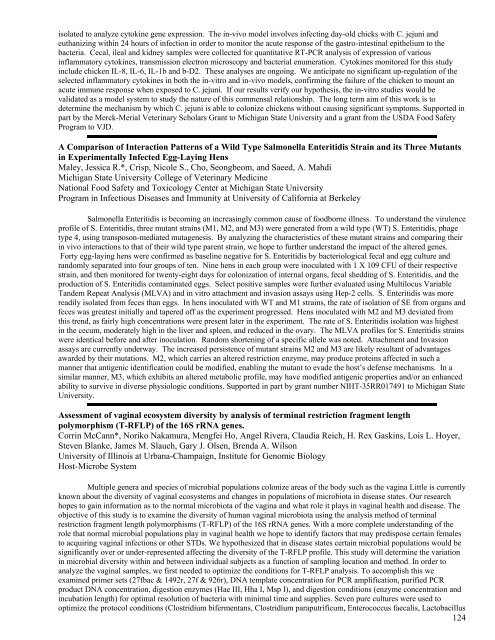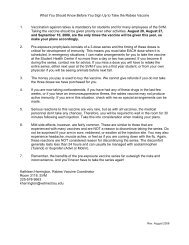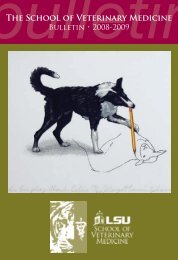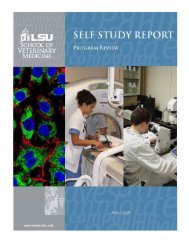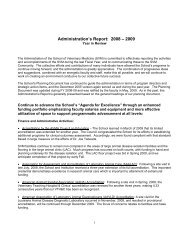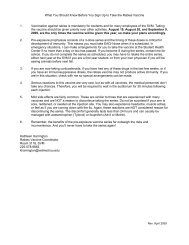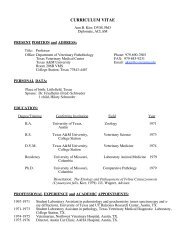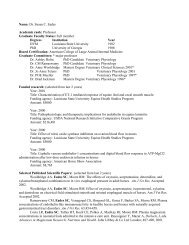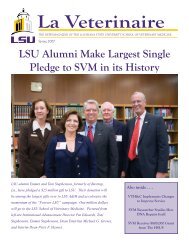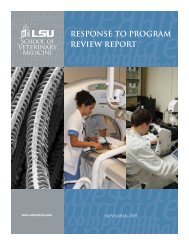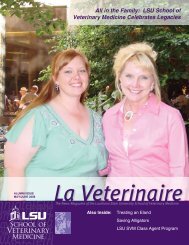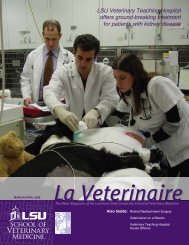isolated to analyze cytokine gene expression. The in-vivo model involves infecting day-old chicks with C. jejuni andeuthanizing within 24 hours <strong>of</strong> infection in order to monitor the acute response <strong>of</strong> the gastro-intestinal epithelium to thebacteria. Cecal, ileal and kidney samples were collected for quantitative RT-PCR analysis <strong>of</strong> expression <strong>of</strong> variousinflammatory cytokines, transmission electron microscopy and bacterial enumeration. Cytokines monitored for this studyinclude chicken IL-8, IL-6, IL-1b and b-D2. These analyses are ongoing. We anticipate no significant up-regulation <strong>of</strong> theselected inflammatory cytokines in both the in-vitro and in-vivo models, confirming the failure <strong>of</strong> the chicken to mount anacute immune response when exposed to C. jejuni. If our results verify our hypothesis, the in-vitro studies would bevalidated as a model system to study the nature <strong>of</strong> this commensal relationship. The long term aim <strong>of</strong> this work is todetermine the mechanism by which C. jejuni is able to colonize chickens without causing significant symptoms. Supported inpart by the Merck-Merial <strong>Veterinary</strong> Scholars Grant to Michigan <strong>State</strong> University and a grant from the USDA Food SafetyProgram to VJD.A Comparison <strong>of</strong> Interaction Patterns <strong>of</strong> a Wild Type Salmonella Enteritidis Strain and its Three Mutantsin Experimentally Infected Egg-Laying HensMaley, Jessica R.*, Crisp, Nicole S., Cho, Seongbeom, and Saeed, A. MahdiMichigan <strong>State</strong> University College <strong>of</strong> <strong>Veterinary</strong> <strong>Medicine</strong>National Food Safety and Toxicology Center at Michigan <strong>State</strong> UniversityProgram in Infectious Diseases and Immunity at University <strong>of</strong> California at BerkeleySalmonella Enteritidis is becoming an increasingly common cause <strong>of</strong> foodborne illness. To understand the virulencepr<strong>of</strong>ile <strong>of</strong> S. Enteritidis, three mutant strains (M1, M2, and M3) were generated from a wild type (WT) S. Enteritidis, phagetype 4, using transposon-mediated mutagenesis. By analyzing the characteristics <strong>of</strong> these mutant strains and comparing theirin vivo interactions to that <strong>of</strong> their wild type parent strain, we hope to further understand the impact <strong>of</strong> the altered genes.Forty egg-laying hens were confirmed as baseline negative for S. Enteritidis by bacteriological fecal and egg culture andrandomly separated into four groups <strong>of</strong> ten. Nine hens in each group were inoculated with 1 X 109 CFU <strong>of</strong> their respectivestrain, and then monitored for twenty-eight days for colonization <strong>of</strong> internal organs, fecal shedding <strong>of</strong> S. Enteritidis, and theproduction <strong>of</strong> S. Enteritidis contaminated eggs. Select positive samples were further evaluated using Multilocus VariableTandem Repeat Analysis (MLVA) and in vitro attachment and invasion assays using Hep-2 cells. S. Enteritidis was morereadily isolated from feces than eggs. In hens inoculated with WT and M1 strains, the rate <strong>of</strong> isolation <strong>of</strong> SE from organs andfeces was greatest initially and tapered <strong>of</strong>f as the experiment progressed. Hens inoculated with M2 and M3 deviated fromthis trend, as fairly high concentrations were present later in the experiment. The rate <strong>of</strong> S. Enteritidis isolation was highestin the cecum, moderately high in the liver and spleen, and reduced in the ovary. The MLVA pr<strong>of</strong>iles for S. Enteritidis strainswere identical before and after inoculation. Random shortening <strong>of</strong> a specific allele was noted. Attachment and Invasionassays are currently underway. The increased persistence <strong>of</strong> mutant strains M2 and M3 are likely resultant <strong>of</strong> advantagesawarded by their mutations. M2, which carries an altered restriction enzyme, may produce proteins affected in such amanner that antigenic identification could be modified, enabling the mutant to evade the host’s defense mechanisms. In asimilar manner, M3, which exhibits an altered metabolic pr<strong>of</strong>ile, may have modified antigenic properties and/or an enhancedability to survive in diverse physiologic conditions. Supported in part by grant number NIHT-35RR017491 to Michigan <strong>State</strong>University.Assessment <strong>of</strong> vaginal ecosystem diversity by analysis <strong>of</strong> terminal restriction fragment lengthpolymorphism (T-RFLP) <strong>of</strong> the 16S rRNA genes.Corrin McCann*, Noriko Nakamura, Mengfei Ho, Angel Rivera, Claudia Reich, H. Rex Gaskins, Lois L. Hoyer,Steven Blanke, James M. Slauch, Gary J. Olsen, Brenda A. WilsonUniversity <strong>of</strong> Illinois at Urbana-Champaign, Institute for Genomic BiologyHost-Microbe SystemMultiple genera and species <strong>of</strong> microbial populations colonize areas <strong>of</strong> the body such as the vagina Little is currentlyknown about the diversity <strong>of</strong> vaginal ecosystems and changes in populations <strong>of</strong> microbiota in disease states. Our researchhopes to gain information as to the normal microbiota <strong>of</strong> the vagina and what role it plays in vaginal health and disease. Theobjective <strong>of</strong> this study is to examine the diversity <strong>of</strong> human vaginal microbiota using the analysis method <strong>of</strong> terminalrestriction fragment length polymorphisms (T-RFLP) <strong>of</strong> the 16S rRNA genes. With a more complete understanding <strong>of</strong> therole that normal microbial populations play in vaginal health we hope to identify factors that may predispose certain femalesto acquiring vaginal infections or other STDs. We hypothesized that in disease states certain microbial populations would besignificantly over or under-represented affecting the diversity <strong>of</strong> the T-RFLP pr<strong>of</strong>ile. This study will determine the variationin microbial diversity within and between individual subjects as a function <strong>of</strong> sampling location and method. In order toanalyze the vaginal samples, we first needed to optimize the conditions for T-RFLP analysis. To accomplish this weexamined primer sets (27fbac & 1492r, 27f & 926r), DNA template concentration for PCR amplification, purified PCRproduct DNA concentration, digestion enzymes (Hae III, Hha I, Msp I), and digestion conditions (enzyme concentration andincubation length) for optimal resolution <strong>of</strong> bacteria with minimal time and supplies. Seven pure cultures were used tooptimize the protocol conditions (Clostridium bifermentans, Clostridium paraputrificum, Enterococcus faecalis, Lactobacillus124
jensenii, Gardnerella vaginalis, Pseudomonas aeruginosa and Gardnerella vaginalis) as well as a mixture <strong>of</strong> these purecultures.Samples from multiple locations <strong>of</strong> the vagina were examined from eight asymptomatic subjects as well as from 23symptomatic subjects. Various bacterial species were resolved by digesting PCR amplicons using bacterial primers 27fbacand 1492r and the enzymes Hae III and Msp I. T-RFLP pr<strong>of</strong>iles <strong>of</strong> samples from the women were compared. Vaginalbacterial diversity <strong>of</strong> the subjects was investigated and differences in diversity <strong>of</strong> the microenvironments in reference to thelocation <strong>of</strong> the samples from the vagina were evaluated.Antimicrobial activity <strong>of</strong> gallium maltolate against intracellular Rhodococcus equiNicole A. Miller,* Ronald J. Martens, Noah D. Cohen, Jessica R. Harrington, Lawrence R. BernsteinEquine Infectious Disease Laboratory, Large Animal Clinical Sciences, College <strong>of</strong> <strong>Veterinary</strong> <strong>Medicine</strong> andBiomedical Science, Texas A&M University. College Station, TXRhodococcus equi pneumonia is one <strong>of</strong> the most severe infectious diseases in foals. Infections by R. equi, afacultative intracellular pathogen <strong>of</strong> macrophages, are also becoming increasingly frequent in immunocompromised people.Evidence suggests that most foals that develop spontaneous rhodococcal pneumonia become infected within the first week <strong>of</strong>life, when their immune systems may be immature or ineffective. There are no effective vaccines available to prevent thisdisease, and on the basis that standard vaccination protocols require several weeks to stimulate an adaptive immune response,vaccines alone would not be expected to control disease. Perinatal prophylactic administration <strong>of</strong> compounds that control R.equi in vivo may provide protection until the foal’s immune system adequately matures or an adaptive immune responsedevelops. Previous studies have shown that gallium concentrates in macrophages and inhibits the growth <strong>of</strong> extracellular R.equi in vitro by competitively inhibiting bacterial iron uptake and metabolism. This study was designed to evaluate the invitro effectiveness <strong>of</strong> gallium maltolate in suppressing growth or killing R. equi inside macrophages. Virulent R. equi (ATCC33701) were grown in media and opsonized with fresh-frozen horse serum as a source <strong>of</strong> R. equi antibody, complement, andtransferrin. R. equi were added to J774 murine macrophage-like cells in 24-well tissue culture plates at a multiplicity <strong>of</strong>infection <strong>of</strong> 10:1. Following phagocytosis, extracellular R. equi were removed with a series <strong>of</strong> washes, and gentamicin wasadded to the media. Gallium maltolate (GaM) (10, 50, or 100 µM) was added to macrophages either: i) overnight prior toinfection; or, ii) immediately after infection. Controls were: i) cells + bacteria without GaM; ii) cells + bacteria + maltol; iii)cells only; and, iv) cells + GaM. Treatments and controls were replicated in triplicate. Macrophages were lysed and R. equiconcentrations were determined by quantitative culture at 0, 24, 48, and 72hr. Results are pending.Gene expression analysis <strong>of</strong> peripherally circulating sorted canine dendritic cell subsetsRachel Moe; R. Curtis Bird, PhD; Bruce F. Smith, VMD, PhDScott-Ritchey Research Center, College <strong>of</strong> <strong>Veterinary</strong> <strong>Medicine</strong>, Auburn UniversityManipulation <strong>of</strong> dendritic cells (DCs), and other pr<strong>of</strong>essional antigen presenting cells (APCs), may be the key toharnessing the immune system to defeat various disease processes. DCs can be used as vectors for autologous vaccination, orvehicles for immune modulation. DC subsets have been identified in the mouse, and these subsets may hold the key toactivating specific immune responses. DC-like subsets can be identified in the peripheral circulation <strong>of</strong> dogs by fluorescentlabeling with specific cell surface markers. To determine if these subsets express specific DC-related genes, the DC-likecells were sorted by high speed flow cytometry into four discrete populations: CD 11c+, CD4+; CD 11c+, CD8+; CD 11c+,CD4− and CD8−; and a rare and previously undescribed population <strong>of</strong> CD11c super-positive. Thesepopulations were cultured in phytohemagglutinin (PHA) activated lymphocyte conditioned media, and harvested at five andten days. Reverse transcriptase PCR (RT-PCR) and quantitative RT-PCR was used to evaluate expression <strong>of</strong> B7-1 (CD80),B7-2 (CD86), CD40, CD205, and L37 (a housekeeping gene) genes in each <strong>of</strong> the sorted populations. Initial data indicatesthat all four populations contain DC, or DC-like cells. Three <strong>of</strong> the four populations express CD205, and all four express B7-2 (CD86). QRT-PCR data is pending.Analysis <strong>of</strong> influenza virus reassortment after co-infection <strong>of</strong> pigs with two swine influenza virus subtypes,H1N1 and H3N2Teresa Negus, Wenjun Ma, Jürgen A. RichtVirus and Prion Diseases <strong>of</strong> Livestock Research Unit, National Animal Disease Center, Ames, IABackground: Swine influenza viruses have a remarkable ability for genetic shift (reassortment). Prior to 1998, SIVswere the “classical” H1N1 (cH1N1) subtype. Then, reassortant events occurred that transfered avian and human influenzagenes into cH1N1 SIVs, producing novel H3N2, H3N1, H1N2 as well as reassortant H1N1 (rH1N1) viruses. Deletions in thenonstructural protein 1 (NS1) (mutant 126) attenuate the virus and we propose it as a modified live virus (MLV) vaccine. TheMLV vaccine <strong>of</strong>fers good protection against homosubtypic (H3N2) and heterosubtypic (H1N1) SIVs.Objectives: We investigated the possibility <strong>of</strong> reassortment between the H3N2-based MLV vaccine (Tx/98NS1▲126) and the H1N1 (IA/30) strain. Viruses present in lung lavage <strong>of</strong> pigs (3 and 5 days after co-infection) were plaque125
- Page 1 and 2:
2006 MERCK/MERIALNATIONAL VETERINAR
- Page 6 and 7:
3:00-3:30 pm BreakNovel therapy for
- Page 8 and 9:
KEYNOTE SPEAKERRonald Veazey, D.V.M
- Page 10 and 11:
Mini Symposium II:Fish Research: A
- Page 12 and 13:
David G. Baker, D.V.M., M.S., Ph.D.
- Page 14 and 15:
Konstantin G. Kousoulas, Ph.D.Profe
- Page 16 and 17:
Joseph Francis, B.V.Sc., M.V.Sc., P
- Page 18 and 19:
dogs with cancer, the potential rol
- Page 20 and 21:
2006 MERCK/MERIALVETERINARY SCHOLAR
- Page 22 and 23:
YOUNG INVESTIGATOR AWARD HONORABLE
- Page 24 and 25:
Mammary epithelial-specific deletio
- Page 26 and 27:
2006 MERCK/MERIALVETERINARY SCHOLAR
- Page 28:
Variation in Q-Tract Length of the
- Page 34:
Novel therapy for humoral hypercalc
- Page 38:
ALTERNATE:Micron-scale membrane sub
- Page 42 and 43:
ABSTRACT TITLES LISTED BY CATEGORY
- Page 44 and 45:
19. A pilot study of cigarette smok
- Page 46 and 47:
36. Development of a murine in vitr
- Page 48 and 49:
ABSTRACT TITLES LISTED BY CATEGORY
- Page 50 and 51:
71. Identification and characteriza
- Page 52 and 53:
85. Age and Gender Influence Ventil
- Page 54 and 55:
ABSTRACT TITLES LISTED BY CATEGORY
- Page 56 and 57:
2006 MERCK/MERIALVETERINARY SCHOLAR
- Page 58 and 59:
10. Preliminary estimation of risk
- Page 60 and 61:
ABSTRACT TITLES LISTED BY CATEGORY
- Page 62 and 63:
47. Osteoprotegerin and Receptor Ac
- Page 64 and 65:
61. A Comparison of Interaction Pat
- Page 66 and 67:
ABSTRACT TITLES LISTED BY CATEGORY
- Page 68 and 69:
ABSTRACT TITLES LISTED BY CATEGORY
- Page 70 and 71:
ABSTRACT TITLES LISTED BY CATEGORY
- Page 72 and 73:
2006 MERCK/MERIALVETERINARY SCHOLAR
- Page 74 and 75: used to label avian heterophils for
- Page 76 and 77: obtained via analysis of time and d
- Page 78 and 79: 0.71mg/dL; p=0.001). Values for hem
- Page 80 and 81: mass and fecundity in prespawning w
- Page 82 and 83: Equine Hoof Laminae Tissue Collecti
- Page 84 and 85: Aspiration Pneumonia in DogsDavid A
- Page 86 and 87: Distortion Product Otoacoustic Emis
- Page 88 and 89: tyrosine phosphorylation is measure
- Page 90 and 91: the gravid and non-gravid females t
- Page 92 and 93: egulatory function as its ortholog,
- Page 94 and 95: PATHOLOGY, TOXICOLOGY, AND ONCOLOGY
- Page 96 and 97: Markers of Oxidative Stress in plas
- Page 98 and 99: has been isolated from all samples
- Page 100 and 101: Matrix metalloproteinase secretion
- Page 102 and 103: Reproductive performance, neonatal
- Page 104 and 105: control to determine the efficiency
- Page 106 and 107: Enhancing the Quality and Reliabili
- Page 108 and 109: grade II MCTs into groups with good
- Page 110 and 111: Transcriptional Regulation of the I
- Page 112 and 113: MICROBIOLOGY AND IMMUNOLOGY (SESSIO
- Page 114 and 115: colonization of the mutant and 6 re
- Page 116 and 117: digestive tracts of these and other
- Page 118 and 119: 100 pfu BRSV. The results show that
- Page 120 and 121: Inhibition of Microneme Secretion i
- Page 122 and 123: Adherent bacilli were present in th
- Page 126 and 127: purified, viral RNA was extracted a
- Page 128 and 129: The effects of co-engagement of TLR
- Page 130 and 131: Occurrence of Leptospira Vaccine Fa
- Page 132 and 133: undifferentiated catecholaminergic
- Page 134 and 135: the concept that the greater detoxi
- Page 136 and 137: quantitative PCR using gene targets
- Page 138 and 139: Rotenone Induced Dopamine Neuron De
- Page 140 and 141: decrease in serum cortisol, with a
- Page 142 and 143: and detrimental impacts on the brai
- Page 144 and 145: actions of cells prior to embryo de
- Page 146 and 147: Utilizing cDNA Subtraction to Exami
- Page 148 and 149: expression in unilaterally pregnant
- Page 150 and 151: Salmonella is increased. Poultry sa
- Page 152 and 153: exports. The estimated prevalence o
- Page 154 and 155: eeding grounds near Minnedosa, MB s
- Page 156 and 157: (PBMC) were isolated using commerci
- Page 158 and 159: 2006 MERCK/MERIALVETERINARY SCHOLAR
- Page 160 and 161: Trainees acquire in-depth knowledge
- Page 162 and 163: comparative pathology and/or resear
- Page 164 and 165: Department of Veterinary Bioscience
- Page 166 and 167: PhD, Director, Center for Comparati
- Page 168 and 169: 2006 MERCK/MERIALVETERINARY SCHOLAR
- Page 170 and 171: MICHIGAN STATEUNIVERSITYJames Crawf
- Page 172: UNIVERSITY OFPENNSYLVANIALindsay Th


